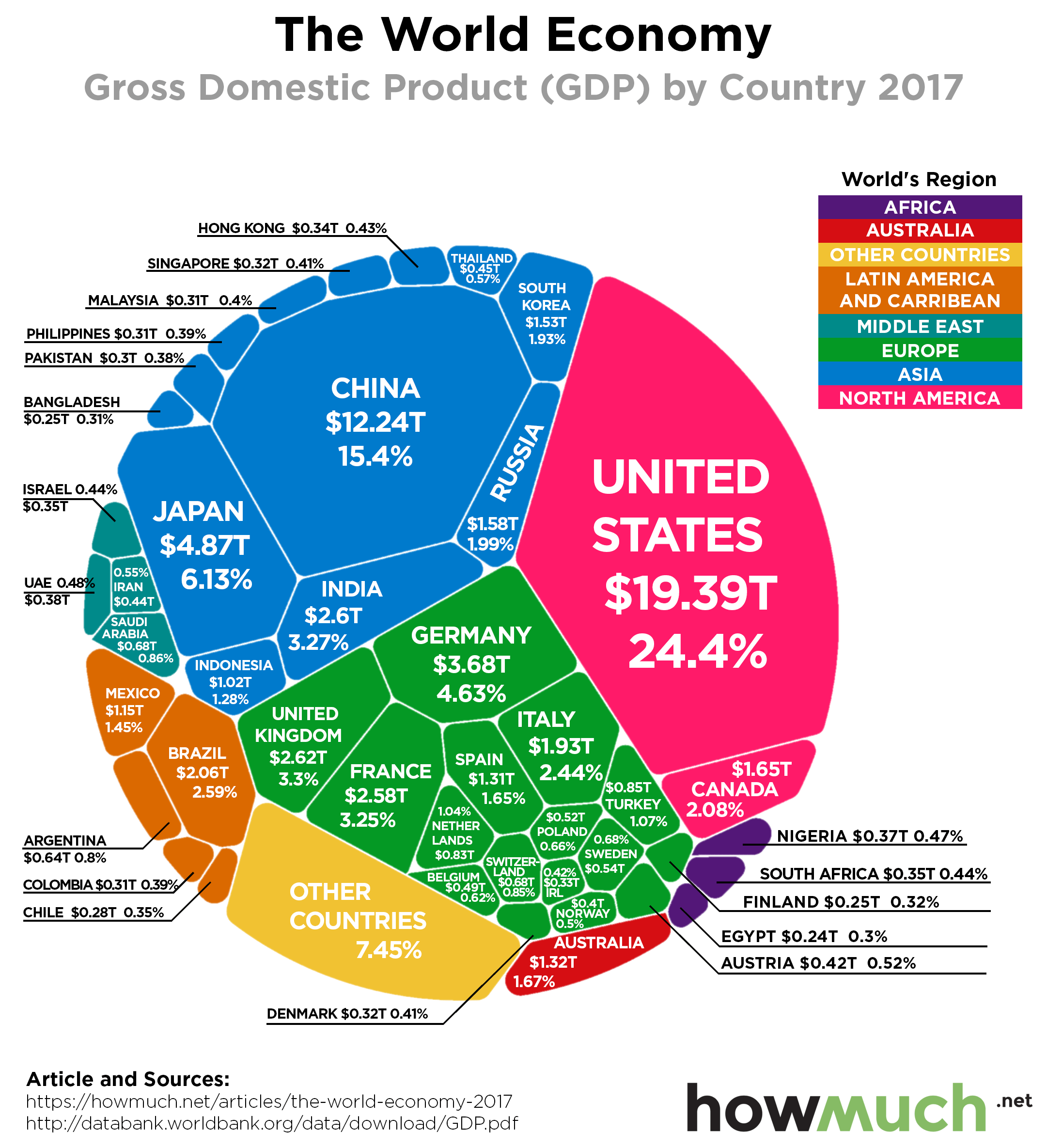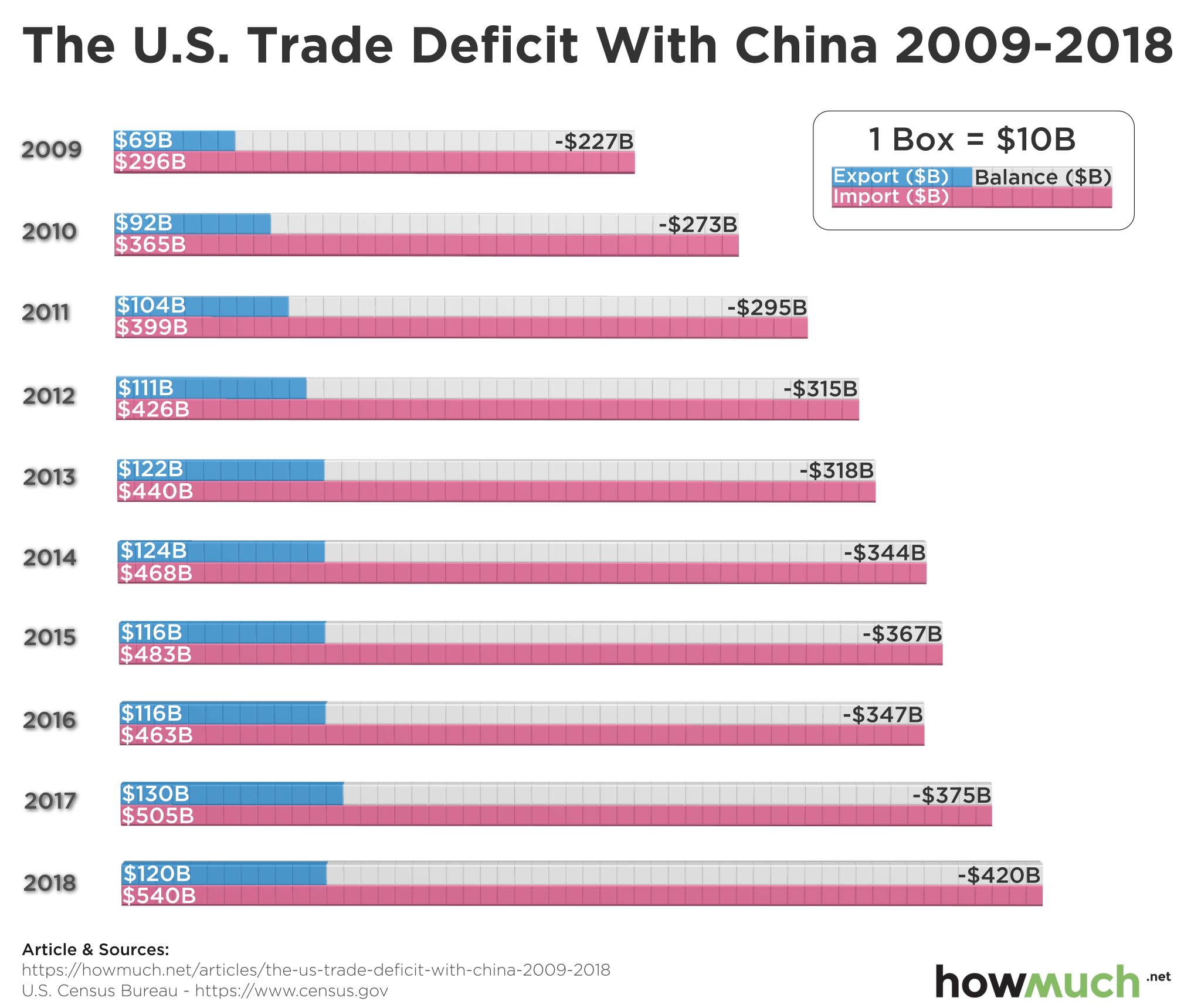![]()
Global trade conjures images of busy ports, planes in the sky, forklifts driving around warehouses - really anything that moves goods. For most of history trade made up the backbone of commerce.
Even though services now make up a significant portion of the global economy, trade still impacts the lives of countries everywhere. Consider why oil rich countries that once offered high standards of living now struggle to tamp down unrest as global commodity (raw materials for production like oil, lumber, natural gas, etc) prices fall.
The graphics below illustrate the relationship between trade and economic wealth. When you view the various trade visualizations you’ll start to see a few interesting points:
- Large countries like the U.S., Russia, and China use trade as a way to conduct foreign policy
- Some countries rely entirely on one commodity to fill their trade coffers
- Countries with high natural resources leverage them and make them large parts of their economy
- Trade is influenced as much by current events as it is by historical ones and cultural characteristics
- Global trade often highlights the concept of comparative advantage; where one country produces a particular item better than others
![]()
It should come as no surprise that China leads the world in global exports with $2.263B a year as they look to expand their economy and influence. Despite what you may think, the United States still exports a ton of goods to the world. It comes in 2nd at $1.547B in exports, mainly driven by high end equipment including machinery and spacecraft.
The visualization clearly displays developed countries dominating the global export economy. Yet, it’s worth noting the growth of emerging economies such as Indonesia and Malaysia picking up steam in recent years.
![]()
Compare the graphics of importers to the previous one on exporters. Notice any similarities? As you might expect, many economies that export rely on heavy import to make finished goods. This tends to break down in economies tied to commodities such as Saudi Arabia who exports twice what they import. However, they still need the equipment to drill for oil.
You’ll often see countries both import and export heavy amounts of goods, even of the same variety. Many countries will import raw materials and export value added items.
![]()
Taking the global view of trade and breaking it down to the state level in the United States, you see similar relationships. High population and low manufacturing states like Florida and California import cars for their population.
You might be questioning why an oil state like Texas imports so much crude oil when they drill so much.Texas operates large amounts of refineries that turn crude oil into petroleum products. Since the capacity exceeds the production in the state, they require more crude oil to be brought in. That’s in part why they export nearly $23.365M in petroleum products each year.
![]()
Did you know that the foreign exchange market trades around $5 trillion per day while the stock market only trades around $200 billion per day? In order for countries to trade they must maintain liquidity (the ability to buy and sell) currencies around the globe. Most countries do this through the U.S. dollar, gold, or a combination. China’s particularly weak currency and high trade volume forces them to hold large amounts of foreign currency to maintain liquidity.
While more developed countries simply invest in gold, emerging markets tend to hold U.S. bonds as a way to maintain liquidity. Consequently, you’ll see in the graphics how some of the largest debt holders outside the United States are key exporters to the world.
However, not holding enough currency can create risk. If China wanted to, they could impact the global value of the dollar simply by flooding the market with U.S. bonds. This is a real possibility and concern for the ongoing trade wars.
![]()
Back before the Bretton Woods Accord of 1971, the United States managed their currency to the price of gold. They eventually found that the country growing too fast, and needed to end this practice. Yet, many developed (and developing) countries around the world still hold large amounts of gold in reserve. Developed countries tend to rely less on foreign currency, since transactions happen more often in their own currency.
Compared to the liquidity chart previously, you’ll notice how the U.S. liquidity is almost entirely made up of gold. Developed countries tend to have a higher percentage of gold making up their liquidity reserves. Emerging markets, like China, will often hold higher reserves of currencies to facilitate trade.
![]()
Everyday we hear about the push for renewable energies. Imagine if the world truly made a meaningful shift to move off of fossil fuels. Guess who would be impacted? Countries like Venezuela, Saudi Arabia, and all the others who rely on Crude Oil exports.
In fact, you can actually see the impacts already. Crude oil prices dropped from over $140 ten years ago to just $50 today. Russia’s currency fell. Saudi Arabia began shifting their economy away from Crude Oil exports. Venezuela confronts civil unrest everyday. Even though the U.S. happens to produce a lot of oil, they consume a good amount locally. Their diverse economy allows them to withstand changes in societal trends.
![]()
One of the most interesting cross-sections of culture and economic wealth sits at diamond imports. Diamond demand tends to ebb and flow with the global economy, as does the supply. Most diamond production comes from a few areas with rich deposits including Russia, several African nations, Australia and Canada.
Countries with large populations, a good amount of disposable income, as well as cultural identities that value wealth happens to be the largest importers. What’s interesting is not so much the United States, but Belgium being such a huge importer of diamonds relative to their population size. Belgium is known as the “Diamond Capital” of the world. During parts of the ‘90s nearly 80% of all diamonds moved through Belgium. While they import a ton, they also export almost the same amount.
![]()
Sometimes imports can be extremely controversial. Weapons sales is a hot button issue both in the United States and around the globe. Countries often sell their military technology to nations to build strategic relationships and allies in various regions.
India and Saudi Arabia make up the largest global imports of military weapons with Egypt coming in 3rd. All of these countries happen to be strategic allies of the United States, and purchase significant amounts from the U.S. Still, some tiny countries like Israel import quite a bit relative to their populations. What’s more interesting is comparing the expenditures of geographies like Europe compared to Asia or the Middle East.
![]()
It shouldn't come as any surprise that some of the largest and technologically advanced militaries in the world tend to export their expertise. The U.S. exports 2x that of Russia, both of which rely on military assistance to influence their global agendas.
Interestingly, you see the large powers of Europe exporting a large amount of arms. While they don’t import that much, they, like the U.S. and Russia, export their technological advantage. You can also see how Israel both imports arms and exports a significant amount as well.
![]()
With the recent election of Boris Johnson as Prime Minister of the United Kingdom, the possibility of the U.K. crashing out of the European Union seems like a very real possibility. Given the large amount of exports the U.K. sends out each year, coupled with what they import, we can look at the winners and losers.
Export powerhouses like the U.S. China, Thailand, and Japan stand ready to backfill the markets left by the U.K. Trading partners like Iceland, Turkey, and a handful of others stand to lose a key importer of their goods.
Trade shouldn’t be analyzed in a vacuum. A true understand of trade means looking at how economies and countries changed over time. If you looked at trade 150 years ago, the world players would be completely different than today. Even 50 years ago would show significant differences.
Today’s economy relies not just on goods but services as well. Two-thirds of the U.S. economy is driven by the service sector. Yet, we can’t dismiss trade entirely. What may seem a paltry part of one economy can be the lifeblood of another. The U.S. may look to wean off of fossil fuels. Yet, they need to understand what that means for their influence with countries such as Saudi Arabia.
What strikes you as some of the most interesting points about these images?



 Our viz highlights the results of a
Our viz highlights the results of a 












































